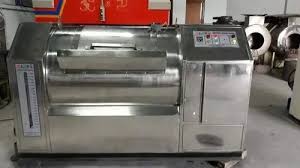Mastering the Art of Laundry: Understanding Standard Procedures and Best Practices

Strong 8k brings an ultra-HD IPTV experience to your living room and your pocket.
Introduction:
Laundry – an unavoidable chore that transcends cultures, climates, and generations. Whether you're a seasoned adult or a novice just stepping into the world of domesticity, laundry equipment manufacturers mastering the art of laundry is essential for maintaining clean and fresh clothing. But what exactly constitutes the standard procedure for laundry? In this comprehensive guide, we delve into the step-by-step process and best practices to ensure your garments emerge spotless, smelling delightful, and retaining their integrity wash after wash.
Understanding the Basics:
Before diving into the intricate details of laundry procedures, it's crucial to grasp the fundamentals. Laundry involves the process of washing, rinsing, and drying textiles, primarily clothing and linens, to remove dirt, stains, and odors accumulated from everyday wear.
Sorting:
The first step in the laundry journey begins with sorting. Separate your laundry into distinct piles based on color, fabric type, and level of soiling. This prevents color bleeding, fabric damage, and ensures optimal washing results. Here's a general sorting guide:
Whites: White clothing, linens, and towels should be washed separately to prevent discoloration caused by dyes from other garments.
Lights: Pastels and light-colored clothing fall into this category.
Darks: Dark-colored items such as jeans, dark towels, and dark linens should be washed together to prevent fading.
Delicates: Delicate fabrics like silk, lace, and lingerie require gentle treatment and should be washed separately or placed in mesh laundry bags.
Heavy-duty: Items like towels, bedding, and sturdy fabrics can withstand more vigorous washing and drying cycles.
Pre-Treating Stains:
Before loading your laundry into the washing machine, address stubborn stains using appropriate stain removers or pre-treatment products. Apply the product directly to the stain, gently rub, and allow it to penetrate the fabric for optimal results. Common pre-treatment methods include:
Enzyme-based stain removers for protein-based stains like blood or sweat.
Oxygen-based bleach for organic stains such as coffee, tea, or wine.
Solvent-based stain removers for oil-based stains like grease or makeup.
Selecting the Right Detergent:
Choosing the correct detergent is pivotal in achieving clean and fresh-smelling laundry. Opt for a detergent formulated for your specific needs, whether it's for standard fabrics, sensitive skin, or high-efficiency (HE) washing machines. Additionally, consider the following factors:
Liquid vs. powder: Both liquid and powder detergents effectively clean clothes, but liquids are often preferred for their ease of use and ability to dissolve in cold water.
Fragrance: Detergents come in a variety of scents, ranging from floral to unscented options for those with sensitivities.
Eco-friendly options: Environmentally-conscious consumers may opt for detergents labeled as biodegradable or phosphate-free.
Loading the Washing Machine:
Once your laundry is sorted, pre-treated, and you've selected the appropriate detergent, it's time to load the washing machine. Follow these guidelines for optimal loading:
Avoid overloading: Overstuffing the washing machine can lead to poor cleaning results and excessive wear on the machine.
Distribute evenly: Ensure an even distribution of clothing to maintain balance during the wash cycle and prevent the machine from becoming unbalanced.
Close zippers and fasten buttons: To prevent snagging and damage to other garments, close zippers and fasten buttons before washing.
Selecting the Wash Cycle:
Modern washing machines offer an array of wash cycles tailored to different fabrics and soil levels. Choose the appropriate cycle based on the following factors:
Fabric type: Delicate fabrics require gentler cycles, while sturdy fabrics can withstand more robust washing.
Soil level: Adjust the wash cycle duration and intensity based on the level of soiling present on your laundry.
Temperature and Water Level:
The temperature and water level settings significantly impact the efficacy of the washing process. Consider the following guidelines when selecting these settings:
Hot water: Ideal for heavily soiled items, whites, and linens, as it helps dissolve detergent and kill bacteria.
Warm water: Suitable for most colored fabrics and moderately soiled items.
Cold water: Best for delicate fabrics, dark colors, and items prone to shrinking or fading.
Drying:
After completing the wash cycle, it's time to dry your laundry. Follow these tips for effective drying:
Read garment labels: Check the care labels on your clothing for specific drying instructions, including temperature settings and drying methods.
Air drying: Hang delicate items to air dry to prevent damage from heat and maintain their shape.
Tumble drying: Use the appropriate heat setting for your garments to avoid shrinkage, overdrying, or damage.
Conclusion:
Mastering the art of laundry is a skill that requires attention to detail, proper technique, and a touch of finesse. By following the standard procedure outlined in this guide and adhering to best practices, you can ensure that your clothing emerges from the laundry cycle clean, fresh, and ready to wear. So, roll up your sleeves, gather your laundry supplies, and embark on your journey to laundry excellence!
Note: IndiBlogHub features both user-submitted and editorial content. We do not verify third-party contributions. Read our Disclaimer and Privacy Policyfor details.


